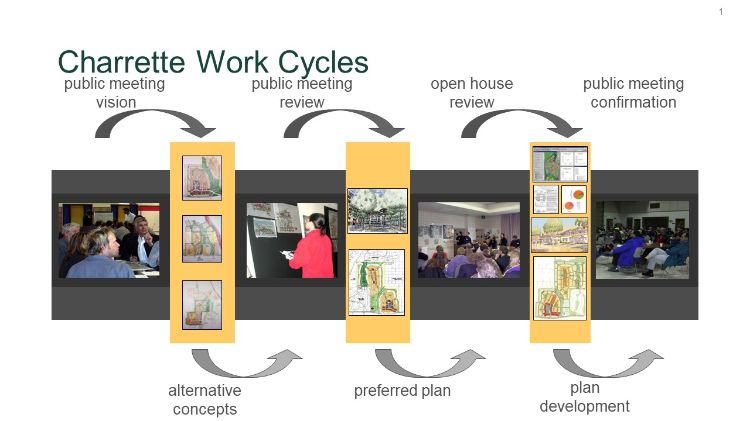What is, or is not, a charrette?
Charrette is a very specific type of public involvement system for design and planning projects. Do not be fooled by people calling every public participation event a charrette.

The term “charrette” has become more popular in recent years yet there are still questions about what a charrette is, compared to other public participation methods. This article serves to clarify what is and is not considered a charrette.
To start, a charrette typically lasts three days and up to seven days. A one-day or one-meeting event is not long enough to include all components of a charrette process.
A charrette is an intense public participation process most often used by planners and developers for a specific design purpose. This first phase of the process includes the collection of ideas and brainstorming, a review by deeply involved stakeholders, and professional designers preparing renderings of what they heard. In the second phase, the renderings of what professional designers prepared are presented so the public can confirm or correct what was prepared, then staff can go back to the drawing boards to revise the design. In the third phase the revised renderings are brought back for public review at a third public event to receive confirmation the drawings reflect the public’s concerns. After this third part, further revision may take place and then work starts on the details necessary for implementation.
This series of three public reviews, or feedback loops (public meeting, do work, public review, do more work, public review) typically occurs in seven days or less. A charrette is used when speed, consensus, and intense attention is desired for a proposal or project. It becomes the full-time, or more than full-time, project for designers, planners, and other staff during the event.
That intense focus on the design project is how the charrette got its name. Teams of architecture students in 1800s Paris would be rushing to finish the architecture design project final exam. Often putting finishing touches on their design while riding on the chart (chariot) to bring the project to the instructor by the deadline. Those students were said to be working en charrette, in the cart. This fast-paced team approach to design carries forward to today’s design charrette, which has become more popular in Michigan.
Charrette has become a very formal planning process, with a national organization producing minimum best practices standards and providing training for charrette management and facilitation. People can obtain this training from the National Charrette Institute, which is housed in the School of Planning, Design, and Construction at Michigan State University, in partnership with MSU Extension. If a community wishes to have a charrette as part of a project it is working on, it may be wise to specify in the request for proposal that the charrette be managed and facilitated by people who have these training certificates.
While we are seeing many different events in Michigan labeled as charrettes, in reality they are not. It is not a charrette if:
- There are only one or two public meetings for the entire process.
- The three meetings are spread out over weeks or months.
- There is not a system of gathering input, and then feedback, re-review, and a second system of feedback.
According to the National Charrette Institute, the following key strategies are essential to a successful charrette:
- All interested parties must be involved in collaboration at the beginning.
- A multi-disciplinary staff is teamed up.
- A schedule compresses work into three to seven days.
- Communication in short feedback loops with quick turnaround to report back to citizens.
Those in Michigan State University Extension that focus on land use provide various training programs on planning and zoning, which are available to be presented in your county. Contact your local land use educator for more information.



 Print
Print Email
Email


